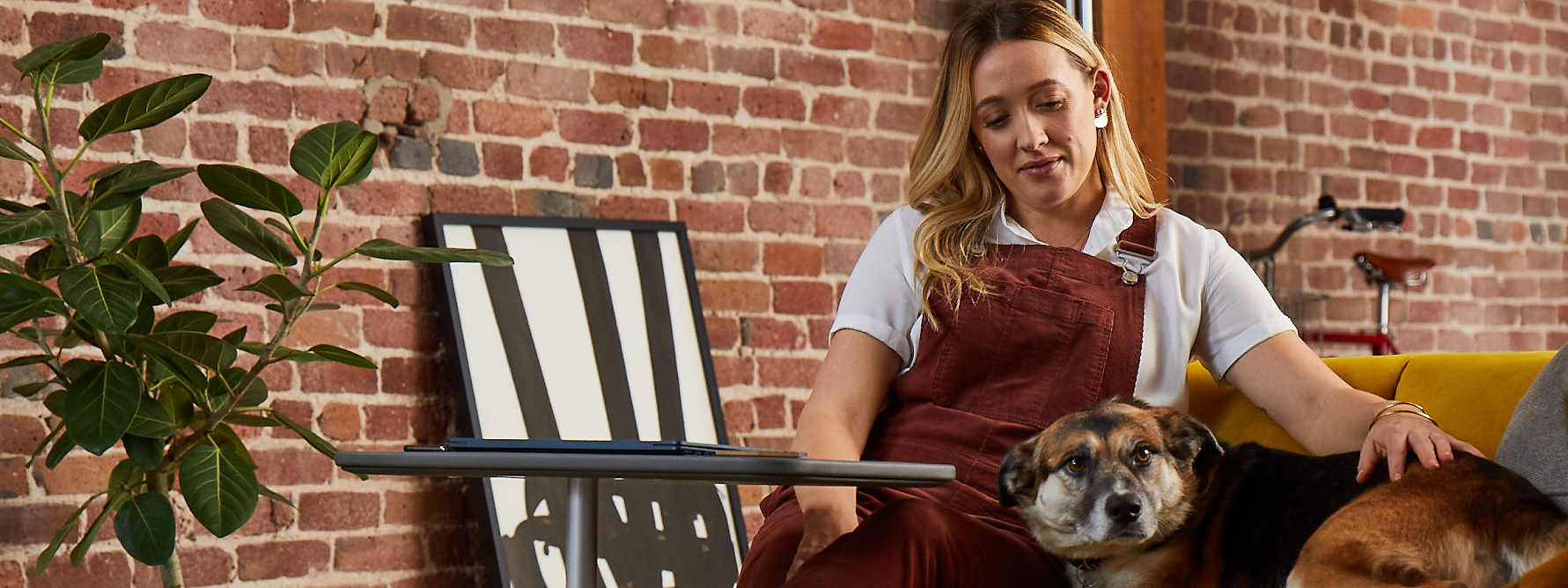
This article is part of our Steelcase 360 series Making Distance Work about working remotely.
By Jill Dark, Steelcase Director of Learning, Leadership and Talent Transformation
Let the dogs bark, let the kid dance, admit that you are in the basement because your spouse is occupying the kitchen. It takes bravery to let the new reality shine.
I was on a video call with our CEO the other day and my dog started barking like crazy. Under normal circumstances, I would have been mortified. Instead, the shared reality of both of us working from home gave him the chance to gain a little more insight into my life (I’m a dog lover).
We’ve long understood that authenticity is an important dimension for emotional wellbeing at work. It’s cultivated by personal expressiveness — the freedom to be who you are at work as well as away from work. But, the reality is, in the office most people are still trying to present their best selves at all times. It’s why we change our clothes when we get home. It’s why we make fun of “corporate speak” yet don’t stop using it. And it’s why we’re always worried about copying the right people in email. We want to be perceived a certain way.
But now, people are taking calls with babies on their knees, partners are walking behind our colleagues during meetings and we’re seeing living rooms and kids bedrooms on video. It’s a whole new normal and a very different set of experiences.
We know people’s behavior is based on what they believe, and what they believe is based on experiences they’ve had over time. For many people, their entire construct and belief system about work is being disrupted right now. We have to recognize that and give people time to adjust. Changing how you work is one thing. Changing what you believe is another.
So, how do we help people? In my role, I connect with people all over the world. I’ve been putting up sticky notes on my walls at home to keep track of what they’re telling me about the pandemic’s impact on their lives and their work. And I’ve been able to start identifying patterns.
At this point (and it may change over time), I’ve identified three macro stages of responses to COVID-19 that will lead to the humanization of work:
Disruption
During disruption people quickly realize the systems and beliefs they have in place about work no longer apply. They can not keep projecting a perfectly professional demeanor while attending a video call from a folding table in their basement. It’s difficult to ignore the adorable five-year-old dancing in a coworker’s background during a video conference. This disruption is exposing our imperfect and beautiful humanness. It provides a unique opportunity for all of us to let our guards down. It gives us a glimpse into the home lives of our coworkers.
Experimentation
The reality of this disruption leads to forced experimentation. Experimentation leads to new experiences and new beliefs. Much like trying to find a new route when encountering construction, people are trying to figure out the best way to navigate. There is much trial and error at first. It’s important during this stage to demonstrate your humanity and let people see your truth. Let the dogs bark, let the kid dance, admit that you are in the basement because your spouse is occupying the kitchen. It takes bravery to let the new reality shine.
New Beliefs
None of us impacted by the pandemic have fully reached a new set of beliefs about work. However, when the pandemic ends, and it will end, we will have accumulated enough experiences to shift our beliefs about work and will begin to operate differently based on our new beliefs. What we stand to gain in showing our truth is a new respect for our shared humanity.
People’s needs are different depending on which stage they are in. But what’s especially interesting is there is a common need that spans all three stages — a focus on emotional wellbeing.
Crisis wellbeing effort
Since I’ve been asked to lead a wellbeing effort during this crisis, let me share how we’ve tried to approach this to help connect with people even while we’re all remote. One initial step is to create a company-wide moment people can do every day. Here’s what we did:
- Create a daily ritual. We’ve created a short morning meditation exercise that’s simple, easy and accessible via live stream and recorded video.
- Have leadership support. Our daily ritual is supported all the way up to our CEO. People will be forced to change their behaviors right now. But, what changes beliefs is when they see senior leaders changing as well.
- Showcase authenticity. I conduct our morning live stream at 7:30 am before I get ready for my work day. I sit in the dark in my kitchen. If I were doing it in person, I would look very different. But, we want people to feel like they can join as they are.
- Allow for anonymity. For some people and cultures, video can cause additional stress and add to feeling exposed. We specifically created our ritual with a “push strategy.” We broadcast the video live and then post the recording. We don’t want our wellbeing ritual to create any additional discomfort, so people join anonymously and take part in any way they choose.
- Consider global teammates. My early morning is my colleague’s evening in Europe or even the next day in Asia. We chose a video recording so our global teammates could participate from anywhere at any time. We don’t care when people take advantage of this ritual, we just want them to incorporate it into their day.
A short, guided mindfulness exercise ritual helps people connect with themselves each day as they prepare to face uncertainty. This pandemic is forcing us all to take a detour from our typical routine. And, depending on how comfortable people are with letting their guard down, they will approach it differently. We’ll see lots of new behaviors and beliefs emerge from this. But most certainly, we’ll see the breaking down of human barriers and a growing comfort with being our true selves at work.
Our suggestion for an easy meditation practice anyone can try.
- Find a stable, comfortable spot to sit.
- Pay attention to your legs. If you’re on a chair, place the bottoms of your feet on the floor. If you’re sitting on a pillow or mat, cross your legs comfortably.
- Keep your upper body straight but not stiff.
- Pay attention to your arms. Your upper arms should be parallel to your upper body. Rest your palms on your legs so it feels natural.
- Let your gaze fall downward. You don’t have to close your eyes. But, don’t focus on anything in front of you.
- Pay attention to the physical sensation of your breath as it moves through your nose or mouth, and notice the rise and fall of your belly or your chest.
- It’s natural for your attention to wander away from your breath. That’s okay. When your mind wanders, gently bring your attention back to your breath.
- Instead of forcing your mind to certain places, try observing them without reacting. Just sit and pay attention. That’s it. Return your mind to your breath again and again without judgment.
- Then, gently lift your gaze (open your eyes if they are closed). Spend a moment noticing the sounds around you, how your body feels, and your thoughts and emotions.
Source: Mindful
Stay in Touch
Sign up to receive a regular email from Steelcase 360. We will keep adding stories, research, insights — anything we’re learning that might be helpful – as well as new story, podcast and magazine releases.
hbspt.forms.create({
portalId: “1822507”,
formId: “081838aa-9302-414c-9009-39f34eedf80b”
});



